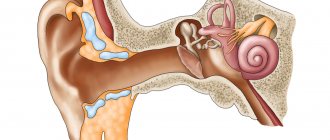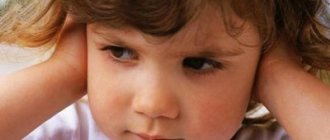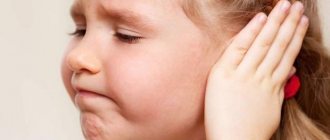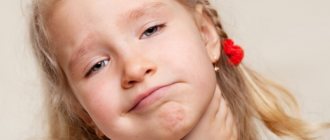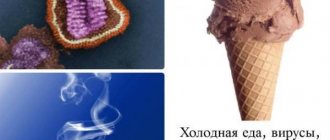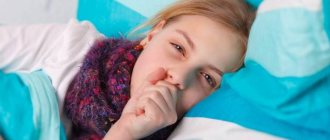Purulent otitis in children is most often observed between the ages of five months and one and a half years. In general, otitis media must be treated in 80 percent of babies in the first three years of life.
This spread of the disease among children is due to the peculiarities of their anatomy. The hearing organs, in particular the Eustachian tube, are not yet fully formed, and therefore cannot be a reliable barrier to the penetration of pathogens into the area of the tympanic cavity and middle ear.
In infants
In infants, bilateral otitis media predominates; it is diagnosed in 90 percent of cases of illness in children under one year of age. In every fifth case, otitis media progresses to the purulent stage.
The auditory tube in a baby is still filled with loose tissue, which has low resistance to microorganisms. The almost constant horizontal position of the child contributes to the stagnation of fluid and the transition of otitis to bilateral.
For obvious reasons, diagnosis in infants has its own characteristics. For example, it is impossible to find out about the presence of noise or congestion in the baby’s ears, but you can measure the temperature or see the increase in pressure in the fontanel. Pain in the baby's ears is checked by lightly pressing the tragus - the protrusion at the base of the ear.
Drops should not be prescribed to infants under one year of age. This is due to the presence of ingredients in them that promote vomiting and cramps.
We advise you to read in more detail: treatment and symptoms of otitis in a newborn child and infant.
Features of purulent otitis media in children
Purulent otitis is a lesion of the middle part of the ear, characterized by inflammation of the mucous membrane and the formation of purulent exudate. The disease rarely occurs in isolation; most often the inflammatory process is a consequence of a viral or bacterial infection.
With purulent otitis media, purulent fluid or exudate accumulates in the middle ear cavity
The pathology is diagnosed in children of different ages, but children under 2 years of age are most susceptible to this disease. Experts explain this predisposition by anatomical features. The Eustachian tube, which connects the nasopharynx to the ear, is much wider and shorter in infants than in adults, so infection spreads from the throat and nasal cavity to the ears more quickly and easily. In addition, the eardrum in infants is thicker, and the mucous membrane that lines the cavity of the middle ear has a loose structure. This helps pathogens actively multiply, increasing the intensity of the inflammatory process.
After the auditory tube acquires a “normal” size and the mucous membrane becomes less loose, the likelihood of developing otitis media in a child will significantly decrease. If the disease does occur, its symptoms will become less pronounced.
Stages
Suppurative otitis media (other names: purulent otitis media, acute otitis media) is the first stage of the onset of the chronic form of the disease. The success of treatment is largely determined by the timeliness and adequacy of medical care and the avoidance of complications.
- The appearance of the first signs of the disease. General ill health, both ears are blocked, continuous noise. Increased temperature, dizziness.
- Increasing pain, congestion and noise in the ears. Especially in a horizontal position on the back, the pain becomes sharp and shooting. The middle ear mucosa is inflamed. Intoxication of the body appears.
- Increased pain. The pain is piercing, shooting, radiating to the temples. Pain from touching the mastoid process.
- Peak pain. The pain begins to be felt in several areas at once, becomes unbearable, covers the areas of the ears and neck, and the teeth, throat, and eyes also hurt. Hearing decreases even more, tinnitus increases, body temperature rises (preperforative stage). The duration of the inflammatory process is from 2 hours to 3 days.
- Easing pain. The beginning of an abundant flow of pus from the ears, but the sensation of noise and hearing loss continues, the body temperature returns to normal (perforated stage). The duration of purulent discharge is about one week.
- The inflammation is stopped, the perforation is scarred (reparative stage).
The disease does not always go through all stages; it often ends without reaching the perforated stage.
Symptoms
Child behavior
- In a baby. Tearfulness, moodiness, desire to turn on the other side (to reduce ear pain). When feeding, nausea, vomiting, breast refusal and constant turning of the head occur.
- In older children. Fatigue, weakness, pale skin color and ear congestion (in the bilateral form - both ears).
Purulent otitis media - a certain increase in temperature, malaise without pain. Then a slight headache, continuous tinnitus, as well as congestion, due to which hearing decreases and autophony begins.
If purulent otitis in a child occurs without pain symptoms, then the main symptom is the gradual accumulation of viscous pus (discovered during a medical examination). In this case, purulent inflammation may manifest itself initially even in other organs.
Acute form
- General symptoms. Congestion, headache and fever (up to 38 and even 40 degrees).
- Purulent inflammation of the tympanic cavity. Melting of tissues inside the cavity, transition to the temporal bone. Decreased immunity. An increase in pressure inside the skull (in a baby it can be clearly seen from the fontanel).
- Rare symptoms with an atypical course. Pus entering the skull. Significant (up to 40 degrees) increase in temperature, general poor health. Headache and dizziness, nausea and vomiting.
What are the symptoms of purulent otitis media in a child?
If the child is already talking, then parents should pay attention to his complaints and changes in behavior.
The most common symptoms of purulent otitis media in children are:
- sharp pain in the ear, shooting,
- body temperature rises to 390,
- noticeable hearing loss,
- the occurrence of a gag reflex,
- dizziness,
- the skin becomes paler than usual,
- increased sweating,
- apathy is visible in behavior,
- pus appears in the ear.
It is worth noting that children are not always willing to say that something hurts them, so in such cases parents have to rely only on their attention, observation, and be patient with such behavior.
A child’s secrecy may be due to a reluctance to disturb parents, fear of upsetting them, or causing distress. And some children are simply afraid of visits to the doctor, and, understanding the necessity and inevitability of visiting a doctor, they simply do not give a reason to seek help.
Treatment
The diagnosis is made after examining the child (otoscopy). An otolaryngologist, by inserting a probe into the auricle, assesses the condition of the tissues and the area of their damage.
As a rule, treatment of the disease takes place at home, but under medical supervision. Most often, the child’s body itself can cope with otitis media in about two days, during which symptomatic medications are taken - antipyretics, painkillers, antihistamines. The need to use antibiotics occurs in only one percent of children with moderate otitis media.
Treatment of acute otitis media caused by purulent microorganisms, determination of the severity of the disease, and the need to use certain methods should be carried out only by a doctor. The consequences of self-medication can be very serious.
Acute otitis media
The child is prescribed bed rest, antibiotics (by prescription) and antipyretic drugs (Paracetamol, Nurofen).
The effectiveness of treatment is assessed by the normalization of key indicators - general improvement in well-being, good dynamics, normal appearance of the eardrum, blood test without signs of inflammation.
If no positive changes are observed, the cavity with pus is opened surgically to remove it.
If necessary, blowing, UHF, and pneumomassage of the ear are prescribed (at the reparative stage).
Bilateral otitis media
Treatment of bilateral otitis is carried out similarly, local drugs (drops) are used for each ear. As a rule, therapy for the underlying disease - ARVI, influenza, etc. - and physiotherapeutic procedures to increase the body's resistance are also required.
Given the seriousness of the disease and the increased risk of complications, treatment in a hospital setting under constant supervision is recommended.
Drops
Before using antibiotics, ear drops are used (for children over one year of age). If otitis is bilateral, drops are dripped into each ear in turn.
Otipax. Local action drug. An anesthetic that relieves symptoms of the disease, but does not replace antibiotics. Harmless for both children and pregnant women. Contraindicated in case of intolerance to the drug and in the presence of cracks in the eardrum (due to the danger of getting into the blood). When using Otipax, nasal drops are required. Can be taken no longer than ten days. At home it is applied using a gauze flagellum.
Useful on the topic: what to do if a child is deaf.
Antibiotics
Antibiotics are prescribed immediately in severe cases of the disease - high (more than 39 degrees) temperature, severe pain, obvious signs of intoxication.
For young children (under two years of age), antibiotics (appropriate for their age) are often prescribed immediately after diagnosis.
- "Augmentin". Allowed for children from three months. Semi-synthetic antibiotic with a wide spectrum of action. Augmentin should not be taken for more than two weeks.
- "Sumamed." Allowed even for babies from six months of age. Has a wide spectrum of action. Especially for children, Sumamed has a fruity taste.
- "Dioxidine". Broad spectrum medicine. Children with otitis are prescribed drops (ear and nasal). Contraindicated for children under 7 years of age and for diseases of the adrenal glands. Prescribed by a doctor when other medications are ineffective.
Treatment of otitis with antibiotics eliminates inflammation and eliminates symptoms, including suppuration. If one antibiotic does not produce results, the doctor prescribes another, with a different active substance.
Causes and consequences
Various factors can provoke purulent otitis media in children. The risk group includes children with anatomical pathologies and weak immunity. Hereditary factors and the course of pregnancy also play a role.
The main causes of acute purulent otitis in a small child are:
- infectious diseases;
- ear injuries;
- hypothermia;
- antibiotic treatment;
- allergy;
- wax plug in the ear;
- foreign objects entering the ear.
Acute otitis media can occur due to allergies to clothing and hats, earrings, food, pets, street dust, etc.
Wax secretions protect the ear from bacteria and dirt. If ear hygiene is not performed correctly, the protective function is disrupted and symptoms of inflammation appear. If treatment is not started, acute catarrhal otitis media develops into purulent lesions of the middle ear. Further delay can lead to a number of complications.
Heavy discharge leads to the destruction of soft tissues and can provoke a carious process on the bones. It is marked by severe pain and a significant increase in temperature. The inflammation may extend beyond the middle ear. In this case, the inner ear is affected, causing symptoms of dizziness and nausea. Acute otitis media can disrupt the functioning of important elements in the ear and lead to hearing loss. There is also a risk of developing meningitis, encephalitis, myringitis, mastoiditis and other complications that cannot be dealt with at home.
Complications
- The pus prevents the eardrum from working normally, which changes its shape (bulges).
- Acute purulent otitis media affects the temporal tissues and begins to spread to the periosteum, as well as the maxillary sinuses. Inflammatory fluid accumulates, causing the mucous membrane to become thicker.
- The duration of the disease for more than one month can provoke mastoiditis (inflammation of the mastoid process) in older children or anthritis in children.
- Damage to the cerebral circulatory system, increased likelihood of stroke.
Even with high-quality treatment, inflammation does not go away without leaving a trace on the eardrum. A scar forms on it at the site of perforation.
